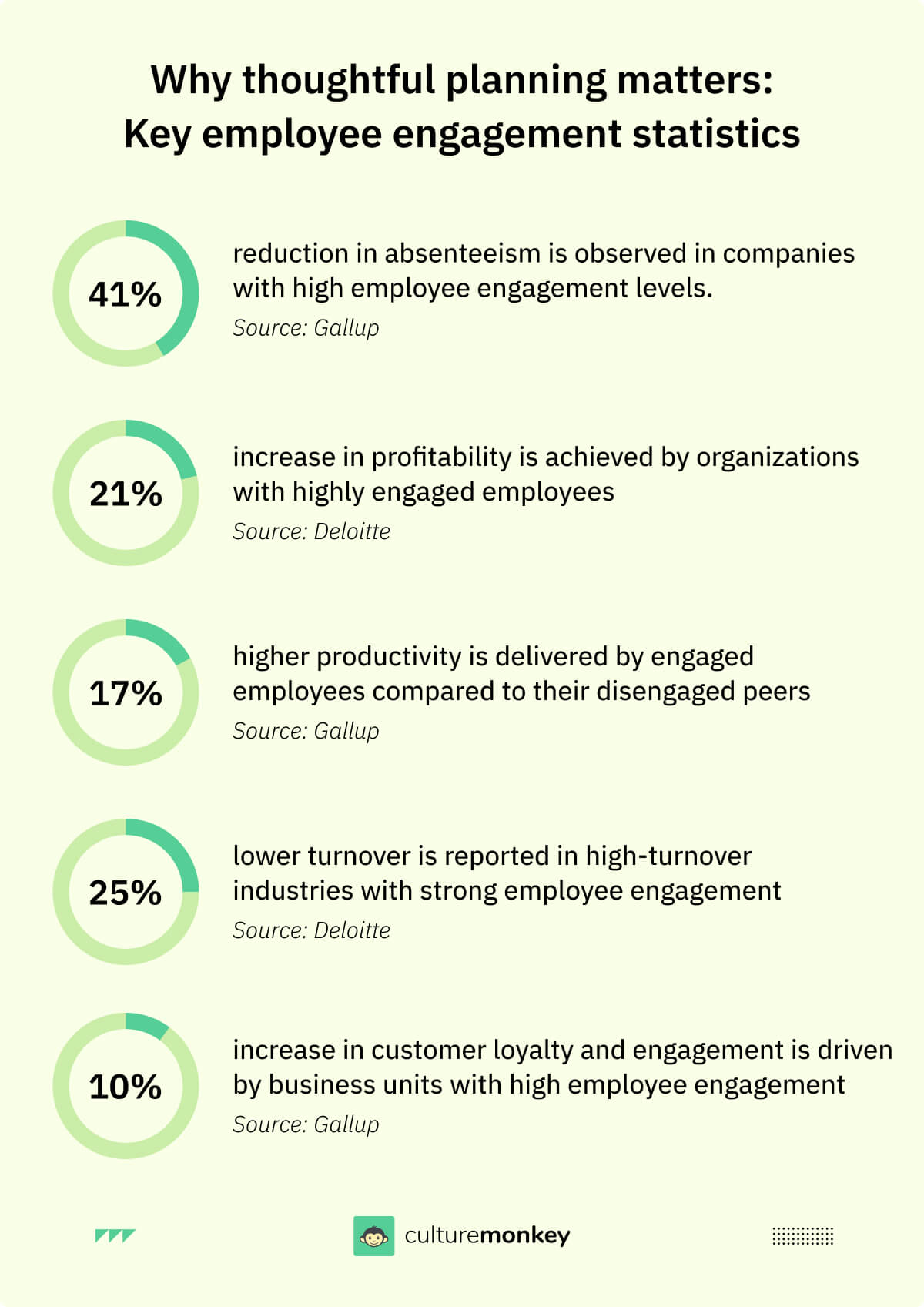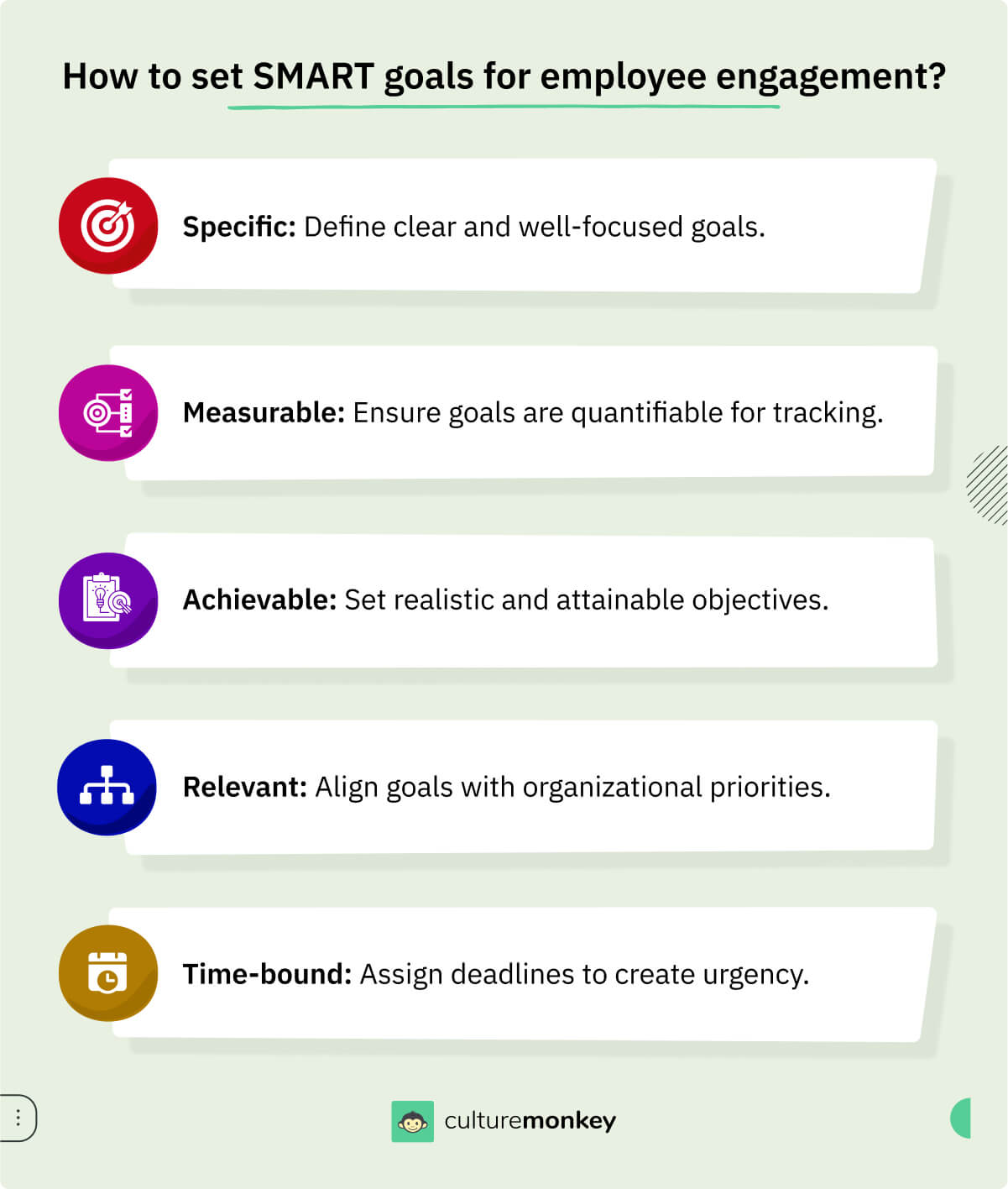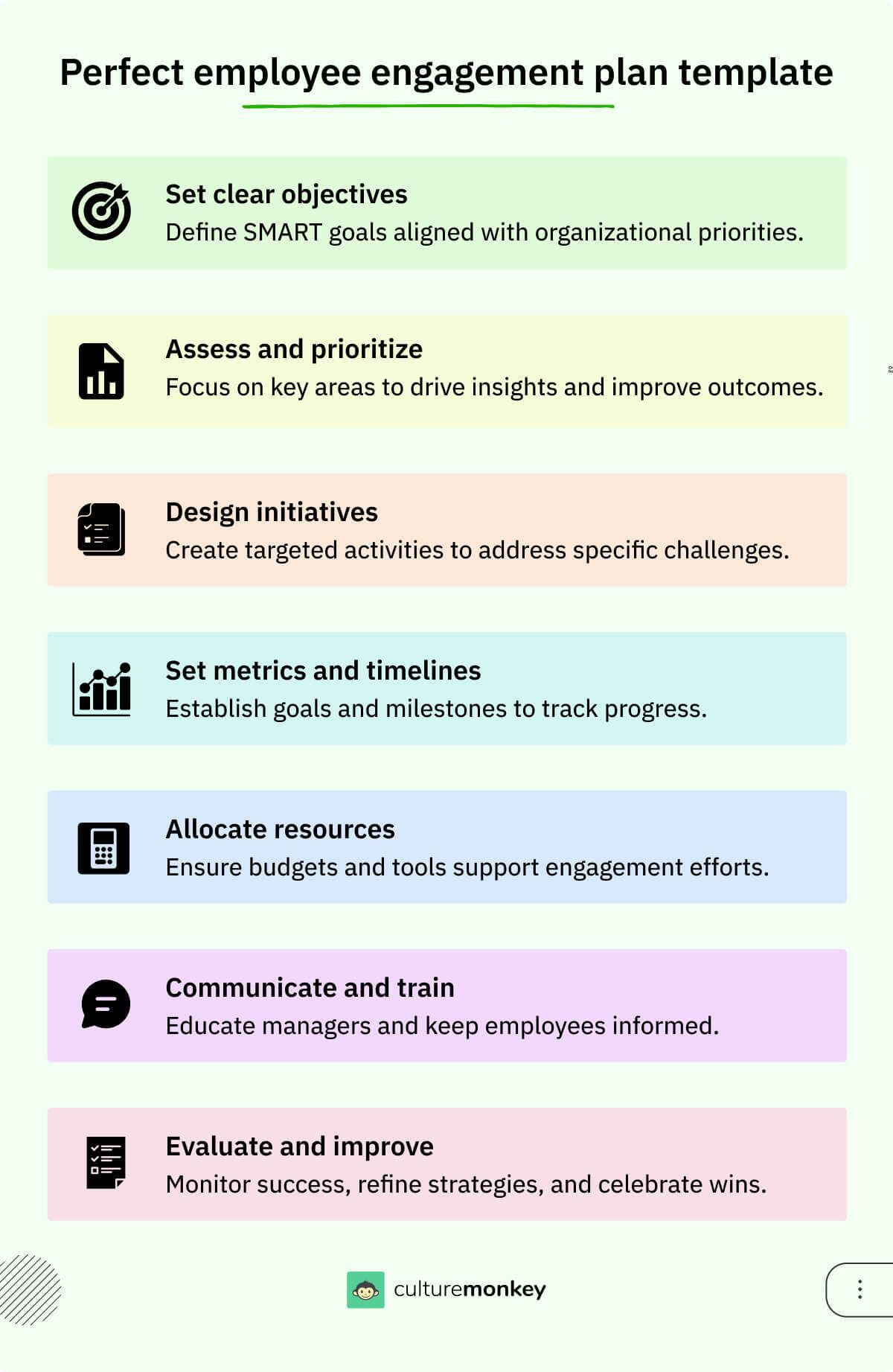How to create the best employee engagement plan in 2024?

Think of Disney’s journey from a small animation studio to a global entertainment powerhouse. Behind the scenes, it wasn’t just Walt Disney’s vision—it was the passion and commitment of his entire team that brought ideas to life.
Walt fostered a unique culture, where every animator, designer, and park employee felt part of the “magic.” By investing in his people and encouraging creativity, Disney turned his team into loyal “cast members” who went above and beyond to create unforgettable experiences.
This is the power of an employee engagement plan that resonates. Imagine crafting an environment where your team feels just as connected and invested in your company’s vision. Ready to build that Disney-level magic in your workplace? Let’s uncover the steps to make it happen.
Blog Highlights


What is employee engagement?

Employee engagement is an organization’s commitment to fostering enthusiasm, dedication, and loyalty among its workforce. More than just job satisfaction, engagement involves a deep alignment with the company’s goals, where employees find value and purpose in their work.
Engaged employees actively contribute ideas, take initiative, and perform at their best, which can transform the workplace into a vibrant, productive environment.
Beyond offering perks, organizations that prioritize engagement create a culture of inclusion, adaptability, and purpose, leading employees to invest their best selves. Such engagement ultimately drives higher productivity, boosts morale, and fosters a resilient workforce aligned with the company’s long-term vision.
What is successful employee engagement?
Successful employee engagement is about creating an environment where your team is not just present but passionately involved in their work. It's that feeling when employees wake up excited to come to work, not just for the paycheck but for the purpose and passion that drives them. Here's the secret sauce to successful employee engagement:
- A sense of purpose: Engaged employees understand the purpose of their work. They see how their roles contribute to the bigger picture, and they're motivated by a sense of meaning and impact.
- Two-way communication: It's not just about management talking to employees; it's about fostering open, two-way communication. Listening to your team's ideas, concerns, and feedback is a crucial part of engagement.
- Growth opportunities: Engaged employees have room to grow. They're given professional development, training, training, and career advancement. They know their organization is invested in their future.
- Work-life balance: Encouraging a healthy work-life balance is essential. Engaged employees aren't burned out; they have time to recharge, which makes them more productive and satisfied.
- Inclusivity and diversity: A diverse and inclusive workplace is a hallmark of engagement. When employees feel welcome and their unique perspectives are celebrated, they're more engaged and innovative.
- Measuring and adapting: Finally, successful employee engagement includes measuring its effectiveness. Use key performance indicators to track progress and be ready to adapt your strategy as needed.
What drives employee engagement?

Understanding what drives employee engagement is crucial to fostering a motivated and committed workforce. By focusing on the core elements that energize employees, organizations can create a culture of passion, innovation, and loyalty. Here are some key drivers that elevate engagement and ensure sustainable success.
- Autonomy in decision-making: Empowering employees to make decisions within their roles enhances trust and accountability. Autonomy encourages innovation and helps employees feel valued for their expertise. This is one of the most effective employee engagement techniques to cultivate a proactive and independent workforce.
- Meaningful work: Employees are more engaged when their roles contribute to a larger purpose. Highlighting the impact of their work on organizational goals fosters pride and dedication. Connecting tasks to meaningful outcomes strengthens internal engagement by reinforcing the value of each contribution.
- Opportunities for cross-functional collaboration: Encouraging employees to collaborate across departments fosters creativity and broadens their perspectives. Cross-functional collaboration helps employees build stronger relationships and understand the bigger picture of organizational goals. This approach also enhances problem-solving capabilities by combining diverse skill sets.
- Recognition for contributions: Acknowledging employee efforts consistently and meaningfully drives higher engagement levels. Whether through formal awards, peer-to-peer recognition, or simple verbal appreciation, recognition reinforces a culture of value and respect. Employees who feel recognized are more likely to stay motivated and committed to their work.
- Access to skill-building resources
Providing employees with opportunities to learn and grow boosts engagement significantly. Offering workshops, certifications, or mentorship programs signals the organization’s investment in their future. Employees who see a path for development are more likely to remain loyal and contribute actively.
What is an employee engagement plan?
An employee engagement plan is like a roadmap that guides organizations on their quest to create a workplace where employees thrive and feel connected to their work and the company's mission.
It's a comprehensive strategy that focuses on nurturing a positive work culture, fostering strong relationships, and empowering individuals to reach their full potential.
Think of it as a series of intentional actions, programs, and initiatives designed to boost employee satisfaction, productivity, and loyalty. An effective employee engagement plan goes beyond traditional perks and benefits, recognizing that true engagement stems from intrinsic motivation and a sense of belonging.
Imagine a workplace where employees are encouraged to voice their opinions and ideas, and where their contributions are recognized and celebrated. Such a plan might include regular feedback channels, opportunities for skill development and growth, team-building activities, wellness initiatives, and meaningful recognition programs.
Ultimately, an employee engagement plan aims to create an environment where employees are not just satisfied with their jobs, but truly engaged and passionate about their work. It's about creating a win-win situation where employees thrive, and the organization benefits from their dedication and commitment.
Purpose of an employee engagement plan

Creating effective employee engagement strategies serves multiple key purposes:
- Boost productivity: Engaged employees bring more energy and commitment, improving efficiency and output.
- Enhance retention: Effective engagement reduces turnover, helping companies retain valuable talent.
- Strengthen team cohesion: Strategies that foster teamwork enhance collaboration and trust.
- Drive innovation: A supportive environment encourages employees to share ideas and take initiative.
- Build strong culture: Engagement strategies shape a positive workplace culture, aligning teams with the company's mission.
Benefits of an effective employee engagement plan
An effective employee engagement plan can be the cornerstone of a thriving workplace, bringing measurable advantages to both employees and the organization. Here are key benefits of implementing an engagement strategy that truly resonates.
- Enhanced problem-solving: Engaged employees contribute innovative solutions, improving operational efficiency.
- Improved brand reputation: Engagement builds a strong employer brand, attracting high-caliber talent.
- Cost savings on training: Higher retention reduces frequent training expenses.
- Increased organizational agility: Engaged teams adapt better to changes.
- Reduced absenteeism: Engagement fosters motivation, reducing time-off.
- Customer satisfaction boost: Committed employees deliver superior service, enhancing customer loyalty.
- Stronger innovation pipeline: Engaged employees consistently share ideas, fostering faster innovation cycles.
- Better workplace resilience: Engaged teams remain adaptable and motivated during organizational challenges.
- Improved peer collaboration: Engagement enhances trust and teamwork, driving better project outcomes.

Challenges in implementing an employee engagement plan and how to overcome them

Implementing an employee engagement plan presents several challenges, including limited resources, difficulty in sustaining momentum, and inconsistent management support. Here's how to tackle them:
- Resource constraints: Start small and focus on high-impact, low-cost initiatives to gradually build support for budget increases. Prioritize initiatives that demonstrate clear, measurable benefits to illustrate value and gain buy-in.
- Maintaining momentum: Establish a regular review and update cycle to keep the plan fresh and relevant. Schedule quarterly check-ins to assess engagement metrics and make any necessary adjustments based on employee feedback.
- Inconsistent management support: Train managers on engagement importance and integrate engagement goals into their KPIs. Encourage leaders to model engagement behaviors, setting a positive example for teams.
- Employee skepticism: Build trust through transparent communication and consistent follow-through on engagement initiatives. Share success stories and tangible results to show employees how their input drives meaningful change.
- Measuring engagement effectively: Tracking engagement can be complex and may feel subjective. Use diverse methods like pulse surveys, one-on-one interviews, and anonymous feedback tools to gather a well-rounded view.
- Adapting to diverse needs: Segment engagement initiatives based on employee roles, demographics, or preferences to ensure inclusivity and relevance, fostering a culture that values individual contributions.
Objectives of employee engagement activities
The objective of employee engagement activities is to build a motivated, dedicated, and connected workforce that aligns with company goals. Key objectives include:
- Enhance job satisfaction: Activities increase morale and job satisfaction by recognizing achievements and supporting development.
- Encourage collaboration: Engagement activities promote teamwork and build stronger interpersonal connections.
- Boost retention: Engaged employees are more likely to stay, reducing turnover.
- Drive productivity: Motivation from engagement leads to higher individual and team productivity.
- Foster innovation: Activities stimulate creativity and encourage employees to share ideas, benefiting overall company growth.
Employee engagement plan vs employee engagement action plan

| Aspect | Employee engagement plan | Employee engagement action plan |
|---|---|---|
| Purpose | Broad framework to foster engagement and satisfaction in the workforce, aligning with organizational goals. | Focuses on specific, actionable steps to achieve goals outlined in the engagement plan. |
| Scope | Covers strategic objectives like communication, career growth, and recognition. | Targets precise tasks, timelines, and milestones needed to fulfill engagement initiatives. |
| Level of detail | High-level overview with general initiatives and long-term goals. | Detailed steps, responsibilities, and measures for progress tracking. |
| Adaptability | Evolves based on changing organizational needs and employee feedback. | Adjusts quickly based on immediate results and data-driven insights from engagement activities. |
| Timeline | Often spans over months or years with periodic reviews. | Operates on shorter cycles, focusing on quick wins and measurable improvements. |
| Example components | Communication strategy, leadership development, cultural alignment. | Specific tasks like holding quarterly town halls, implementing recognition software, or creating mentorship programs. |
Positive impacts of employee engagement in an organization

Employee engagement has a multitude of positive impacts that reverberate throughout an organization, creating a ripple effect of success.
The primary goal is to battle employee disengagement, which is a state that occurs when employees lack motivation, commitment, and enthusiasm toward their work. It's like having a "meh" attitude, resulting in low productivity and a sense of detachment. Watch for signs of disengagement like absenteeism, decreased performance, and a negative vibe.
Now, let's explore a few of the remarkable benefits of trying to boost employee engagement:
- Enhanced productivity: A happy employee is motivated, focused, and committed to achieving their best. They take ownership of their work, consistently going above and beyond expectations. This heightened productivity not only leads to improved individual performance but also contributes to the overall success of the organization.
- Improved employee satisfaction: An engaged workforce translates into higher levels of job satisfaction. Employees who feel valued, supported, and challenged in their roles are happier and more fulfilled. This positive sentiment spills over into their interactions with colleagues, customers, and stakeholders, contributing to a harmonious work environment.
- Boosted innovation and creativity: Engagement creates an environment conducive to innovation and creativity. An engaged employee feels empowered to share their ideas, take calculated risks, and collaborate with their peers. This fosters a culture of continuous improvement and fuels innovation, leading to new ideas, processes, and solutions that drive organizational growth.
- Strengthened organizational culture: A culture of engagement becomes the bedrock of an organization's identity. It shapes how employees interact, collaborate, and align with the company's values. A strong culture of engagement fosters trust, open communication, and teamwork, creating a positive work environment where everyone can thrive.
- Enhanced teamwork and collaboration: Employee engagement also leads to improved teamwork and collaboration. Engaged employees are more likely to share their knowledge, support their colleagues, and work cohesively towards common goals. This strengthens the overall team dynamics and enhances the organization's ability to tackle complex challenges effectively.
- Higher profitability and growth: Engaged employees have a direct impact on an organization's profitability. Their heightened productivity, innovation, and commitment translate into increased revenue and growth. By consistently delivering excellent results and driving customer satisfaction, engaged employees contribute to the company's financial success.
- Reduced absenteeism and tardiness: Employee engagement reduces absenteeism and tardiness.Their enthusiasm and dedication make them more inclined to show up consistently, contributing to a more stable and productive work environment.
What are the 5 goals of engagement?
Employee engagement isn't just a buzzword; it's a critical factor in building a thriving and successful workplace. To make the magic of engagement happen, it's essential to set clear goals. Let's explore the five key goals of employee engagement that every organization should strive to achieve.
1. Boost employee morale
One of the primary goals of engagement is to boost employee morale. Happy employees are productive employees. When your team is motivated and content, they are more likely to bring their best selves to work every day. Employee morale isn't just about having a ping-pong table in the break room; it's about creating a work environment where people feel valued, respected, and appreciated.
2. Foster innovation
Engagement should encourage and foster innovation. When employees feel engaged, they are more likely to share their creative ideas and suggestions. An engaged workforce is a hotbed of innovation. It's a place where employees feel comfortable speaking up, knowing their ideas will be heard and, where applicable, implemented.
3. Improve productivity
Increased productivity is a natural outcome of engaged employees. When your team is excited about their work, they put in more effort and energy. They're more focused and committed to achieving company goals. The result? Higher productivity levels, better work output, and ultimately, more success for your organization.
4. Enhance employee well-being
Employee engagement also aims to enhance employee well-being. It's about creating an environment where employees aren't just cogs in the corporate machine but whole individuals with physical and emotional needs. Promoting work-life balance, offering wellness programs, and providing support for mental health are all part of this goal.
5. Boost employee retention
High turnover rates can be a significant drain on resources. Engaged employees are more likely to stick around. They have a sense of loyalty to the organization and are invested in its success. Reducing turnover not only saves on recruitment costs but also maintains a stable workforce with valuable institutional knowledge.
How to identify a goal of an employee involvement team?

- Start with the "Why": The very first step in identifying EIT goals s to understand why the team exists. What's the purpose? Is it to enhance employee morale, foster innovation, boost productivity, or address specific workplace issues? Defining the "why" sets the foundation for your goals.
- Survey the troops: Your EIT should be a reflection of your workforce's needs and aspirations. Conduct surveys, hold focus group sessions, or simply talk to your colleagues. What are the pain points, ideas, or improvements they're looking for? These insights will shape your goals.
- SMART goals: Remember the SMART acronym - Specific, Measurable, Achievable, Relevant, and Time-bound. Your EIT goals should embody these qualities. For example, if your "why" is to enhance employee morale, a SMART goal could be to organize monthly team-building events that increase participation by 20% within the next quarter.
- Alignment with company objectives: It's crucial that your EIT goals align with your company's overall mission and values. If your organization aims to become a leader in sustainability, your EIT goals should tie into this objective, such as reducing waste or promoting eco-friendly practices.
- Prioritize and sequence: It's tempting to have a laundry list of goals, but it's wiser to prioritize and sequence them. What's the most pressing issue? What can you realistically tackle first? Maybe it's addressing employee burnout before moving on to diversity and inclusion initiatives.
- Regular review and adaptation: Your EIT's goals aren't set in stone. Review and adapt them as needed. If a goal has been met, celebrate it, and then set a new one. If circumstances change, be ready to pivot.
- Measuring success: It's essential to have metrics in place to measure your EIT's success. This could be in the form of feedback surveys, participation rates, or tangible outcomes like reduced absenteeism or increased employee satisfaction scores.
- Communication is key: Share your goals with the entire organization. Transparency is critical. Let everyone know what the EIT is working towards, and encourage their involvement and feedback.
- Celebrate milestones: When your EIT achieves a goal, celebrate it! Acknowledging the team's hard work and success not only boosts morale but also motivates others to get involved.
How to set smart goals for employee engagement?

Engaging your employees isn't just about handing out free snacks or organizing the occasional team-building event. It's about setting clear and effective goals that lead to a more motivated, productive, and satisfied workforce. SMART goals are the key to achieving this. So, let's dive into the recipe for success when it comes to setting SMART goals for employee engagement.
S - Specific
The first ingredient in our SMART goal recipe is "Specific." Employee engagement goals should be crystal clear and well-defined. Vague objectives won't get you far. For instance, instead of setting a goal like "Improve employee morale," aim for something more specific: "Increase the monthly employee recognition program participation by 25% within the next quarter." This clear objective leaves no room for ambiguity.
M - Measurable
The "M" stands for "Measurable." Your goals should be quantifiable, so you can track progress and determine when they've been achieved. In the example above, "Increase the monthly employee recognition program participation by 25%" is a measurable goal. You can easily track participation rates and determine if you've hit the mark.
A - Achievable
"Achievable" is the third ingredient. Goals should be realistic and attainable. Setting unattainable objectives can lead to frustration and demotivation. It's crucial to assess your resources, constraints, and the current state of your organization before setting these goals. If your employee recognition program is is currently suffering from low participation, a 25% increase in one quarter might be challenging but still achievable with the right strategies.
R - Relevant
The "R" in SMART goals stands for "Relevant." Your goals should be relevant to your organization's broader mission and employee engagement efforts. They need to align with your company's culture, values, and overall objectives. For instance, if your company is committed to sustainability, setting an employee engagement goal to reduce office waste aligns perfectly with your values.
T - Time-bound
The final ingredient is "Time-bound." Your goals should have a clearly defined timeframe for completion. Without a deadline, goals can linger indefinitely. In our example, the goal is to increase employee recognition program participation by 25% within the next quarter. This timeframe creates a sense of urgency and accountability.
Essential components for an employee engagement plan

Crafting an employee engagement strategy requires a thoughtful approach that aligns with organizational goals and employee needs. A well-rounded plan focuses on building meaningful connections, fostering trust, and driving long-term commitment. Here are the essential components that ensure your engagement initiatives create a thriving and motivated workforce.
- Onboarding experience enhancement: A strong onboarding program sets the tone for your talent engagement strategies from day one. Beyond paperwork, focus on creating a welcoming environment with structured introductions, team mentoring, and clear role expectations. An effective onboarding process leaves new hires feeling supported and aligned with the company’s vision.
- Recognition of team achievements: While individual recognition is vital, celebrating team accomplishments fosters collaboration and collective pride. Highlight the impact of group efforts in meetings, newsletters, or team-building events. Recognizing teams reinforces the value of working together toward shared goals.
- Leadership visibility and accessibility: Employees feel more connected when leadership is approachable and visible in day-to-day operations. Regularly scheduled leadership town halls, open-door policies, and casual meet-and-greets bridge the gap between management and employees. This fosters trust and a sense of inclusion in organizational decision-making.
- Flexible work options: Flexibility has become a cornerstone of employee engagement in today’s evolving workplace. Offering remote work opportunities, flexible hours, or hybrid setups accommodates diverse needs and promotes work-life balance. Flexibility signals trust and respect, driving higher job satisfaction and retention.
- Feedback action loop: Engagement thrives when employees see that their feedback leads to meaningful change. Create a transparent system to collect, analyze, and act on suggestions, keeping employees informed of progress. A visible feedback loop builds trust and motivates continuous participation.
How does employee engagement differ from job satisfaction?
Employee engagement and job satisfaction are often used interchangeably, but they represent distinct concepts. While job satisfaction focuses on how content employees are with their roles, employee engagement goes beyond contentment to measure emotional commitment and investment in organizational goals.
Job satisfaction typically revolves around external factors like salary, work environment, and benefits. Employees may feel satisfied if these elements meet their expectations, yet this doesn’t guarantee they are motivated or performing at their peak. Satisfaction is a passive state, where employees are content but not necessarily driven to excel.
In contrast, employee engagement reflects an active connection to one’s work and the organization. Engaged employees take initiative, align with company values, and strive to make a meaningful impact. They are more likely to innovate, collaborate, and go the extra mile to achieve results.
Ultimately, while job satisfaction contributes to retention, employee engagement drives productivity, innovation, and organizational success.
Things to consider while creating your employee engagement plan

When crafting your employee engagement plan, there are several key factors to consider. By paying attention to these aspects, you can ensure that your plan is effective, tailored to your organization's unique needs, and sets the stage for a thriving workforce. Here are a few important considerations:
- Align with organizational values: Ensure your engagement plan reflects the company’s values, mission, and culture. When employees see alignment between their roles and company goals, they experience greater purpose. This fosters commitment, as employees feel part of a meaningful vision.
- Provide growth and development opportunities: Offer clear pathways for career advancement, training programs, and mentorship opportunities. Employees value growth and skill-building, which boosts long-term engagement. Supporting career development improves job satisfaction and retention.
- Foster open communication: Establish channels for open, transparent communication, encouraging feedback and suggestions. Involve employees in discussions, ensuring their voices are respected. Open communication strengthens trust and promotes a collaborative culture.
- Continuously measure and adapt: Regularly assess engagement through surveys and feedback tools to gauge effectiveness. Use data-driven insights to refine initiatives, addressing areas that need improvement. Ongoing evaluation ensures your plan stays relevant.
- Provide opportunities for skill development: Encourage continuous learning by offering opportunities for skill acquisition and improvement. When employees see a commitment to their growth, they’re more likely to stay engaged. A culture of learning fosters loyalty and performance.
- Emphasize diversity and inclusion: Create an inclusive culture that respects diverse perspectives and experiences. Embracing diversity helps employees feel safe and valued for their unique contributions. An inclusive environment strengthens collaboration and innovation.
- Enhance employee well-being: Prioritize holistic well-being with wellness programs and mental health support. Healthy, content employees are more productive and committed to their roles. Well-being initiatives demonstrate that you care beyond work output, fostering long-term loyalty.
How to create a perfect employee engagement plan template

Creating a perfect employee engagement plan template involves careful consideration and thoughtful planning. Here are the essential steps to guide you in developing an effective template for your organization:
- Set clear objectives: Establish clear, SMART objectives to align your engagement plan with organizational goals. Specific objectives provide focus, create benchmarks for progress, and motivate employees. For example, aim to “increase morale by 15% within six months through recognition initiatives.” Regularly review objectives to adjust as needed.
- Assess current engagement levels: Start by measuring current engagement through surveys, focus groups, or engagement tools to collect meaningful data. Use both quantitative and qualitative insights to understand satisfaction, communication, and growth areas. Regular assessment helps pinpoint improvement areas and prioritize action.
- Identify key focus areas: Define main focus areas based on assessment data—such as communication, recognition, or work-life balance. Align these focus areas with company needs and employee feedback. Focus on high-impact areas that resonate with employees and the organization.
- Design engaging initiatives: Create initiatives that address key focus areas and encourage employee participation. For communication, consider town halls or feedback sessions. Think creatively and choose initiatives that authentically connect with your workforce and drive engagement.
- Set measurable goals: Define measurable goals for each initiative, like participation rates or engagement scores. Clear goals will help track progress and inform data-driven improvements. Monitor these metrics closely to evaluate each initiative's success over time.
- Create an implementation timeline: Outline a clear timeline for rolling out initiatives, considering dependencies and resources needed. A structured timeline ensures smooth execution and keeps everyone aligned. Regular updates keep stakeholders informed and engaged in the process.
- Allocate resources: Ensure sufficient budget, personnel, and technology support for each engagement initiative. Adequate resources foster successful and sustainable plan implementation. Prioritize resources based on areas with the greatest potential impact.
- Communicate and train: Communicate the engagement plan’s purpose and initiatives to managers, employees, and leadership. Provide training to managers on their roles in fostering engagement. Clear communication reinforces the plan’s goals and keeps everyone aligned.
- Monitor and evaluate: Continuously track the effectiveness of each initiative through employee feedback and data analysis. Adjust strategies as needed to keep the plan relevant. Regular evaluation against set goals ensures the engagement plan remains impactful.
- Celebrate success and iterate: Celebrate achievements by recognizing teams and employees contributing to the plan’s success. Use feedback and insights to refine the engagement plan for future improvements. Engagement is an evolving process, so prepare to adapt the plan as the organization grows.
Employee engagement plan template
An effective employee engagement plan template provides a structured approach to leveraging employee surveys and building a connected workforce. By outlining key components, it ensures every initiative is goal-driven, actionable, and measurable, aligning employee needs with organizational objectives.
Start with identifying areas of improvement through employee engagement surveys. Highlight specific challenges to address, such as communication gaps or low morale, to prioritize focus areas.
Assign a task owner to each initiative to ensure accountability. Clearly define potential solutions, such as introducing team-building workshops or improving recognition programs, tailored to address identified issues.
Create an employee engagement survey questions that are tailored to uncover valuable insights, enabling you to define success metrics like improved survey scores, reduced turnover, higher productivity levels, or initiatives that directly improve employee engagement. Include a clear timeline with milestones to track progress, ensuring that initiatives remain on schedule and impactful.

Build a Winning Employee
Enagagement Action Plan
A step-by-step guide to create an employee engagement plan that boosts motivation, satisfaction, and productivity.
25+ Sample survey questions to measure your employee engagement plan

Employee engagement is a critical driver of business success, as shown by Gallup's research on its impact on performance outcomes. The study revealed that higher levels of employee engagement significantly improve key metrics such as customer loyalty, productivity, and profitability while reducing turnover, absenteeism, and safety incidents. Simply put, organizations with engaged employees are more than twice as likely to achieve superior business outcomes compared to those with low engagement levels.
To evaluate the effectiveness of your employee engagement initiatives, it’s essential to gather insights through well-crafted survey questions. Below are categorized sample questions to help you measure various facets of your employee engagement action plan.
Overall Engagement
- How motivated are you to give your best effort at work every day?
- Do you feel proud to be a part of this organization?
- Would you recommend this company as a great place to work?
- Do you feel your work directly contributes to the organization’s success?
- How satisfied are you with your overall employee experience?
Belonging
- Do you feel a sense of belonging within your team?
- Are your unique perspectives and contributions valued by your colleagues?
- Do you feel included in decisions that affect your role or department?
- How well does the company foster an inclusive and welcoming environment?
- Are you comfortable being your authentic self at work?



Highly engaged employees make the customer experience. Disengaged employees break it.
Founder and CEO
LeaderFactor
Communication
- How effectively does management communicate organizational goals and updates?
- Do you feel encouraged to share your ideas and opinions?
- How often do you receive constructive feedback to improve your performance?
- Do you feel your voice is heard and respected during team discussions?
- Are communication channels within the organization clear and accessible?
Professional Development
- Do you have access to opportunities for career growth and skill development?
- How well does the organization support your professional goals?
- Are you provided with the tools and training needed to excel in your role?
- Do you receive regular mentorship or coaching to help you grow professionally?
- Do you feel your potential for advancement is recognized by leadership?
Rewards and Recognition
- Do you feel adequately rewarded for your contributions to the organization?
- Are recognition programs consistent and meaningful across the company?
- How satisfied are you with the frequency of recognition for your work?
- Do you feel your efforts are appreciated by both peers and management?
- Is there a fair and transparent process for determining rewards and promotions?
- Are recognition opportunities equally accessible across all departments and teams?

Top 15 Survey Questions for Your
Employee Engagement Plan
A detailed list of 15 survey questions to enhance your engagement plan and drive workplace success.
What is employee key engagement strategy?

At its core, an employee key engagement strategy is a well-thought-out plan designed to create an environment where employees are not just content but passionate about their work. It's about igniting that spark in your team, turning them into enthusiastic champions of your organization's mission.
Here are the key elements of an effective employee engagement strategy:
- Communication: Open, transparent, and frequent communication is vital. Employees should be in the loop about company goals, changes, and even challenges. Their input should be valued, and they should know that their voices matter.
- Inclusivity and diversity: Promote a workplace that celebrates differences and welcomes diverse perspectives. An inclusive environment fosters engagement and innovation.
- Health and wellness programs: Offer wellness initiatives to support physical and mental health. Healthy employees are happier and more productive.
- Feedback and surveys: Regularly seek feedback from employees through surveys or one-on-one discussions. This helps you understand their concerns and make improvements.
- Leadership and management: Ensure that your leadership team is engaged and sets an example. Effective management practices play a crucial role in employee engagement.
- Social connection: Create opportunities for employees to connect and build relationships. Social events, team-building activities, and collaborative projects can help foster a sense of belonging.
- Measuring and adjusting: Set key performance indicators to measure the effectiveness of your strategy. If certain aspects aren't working, be ready to adjust and evolve your approach.
Examples of employee engagement plans that work
- Company-wide mentorship programs: Implementing mentorship programs where experienced employees guide and support newer employees can foster a sense of connection and professional growth. For example, a technology company pairs senior developers with junior developers to provide guidance and career development opportunities.
- Wellness initiatives: Prioritizing employee well-being is key to engagement. An insurance company offers wellness programs such as yoga classes, meditation sessions, and health challenges to promote physical and mental well-being. These initiatives improve employee health and foster a positive work environment.
- Continuous learning opportunities: Providing opportunities for continuous learning and skill development can enhance engagement. A consulting firm offers a learning platform with many courses and encourages employees to pursue professional certifications.
- Employee resource groups (ERGs): Establishing employee resource groups can foster a sense of belonging and inclusion. For example, a multinational corporation creates ERGs focused on promoting diversity and inclusion, such as groups for women in leadership, LGBTQ+ employees, or multicultural networking. These groups provide support, networking opportunities, and a platform for sharing experiences.
- Employee development and training programs: Implementing ongoing development and training initiatives demonstrates a commitment to employee growth. An educational institution offers its faculty and staff access to courses, workshops, and certifications to continually enhance their knowledge and skills.
- Innovative team-building activities: Organizing unique team-building activities can inject energy and creativity into the workplace. A technology startup arranges "innovation challenges" where employees work in cross-functional teams to solve real company challenges. This not only fosters teamwork but also generates fresh ideas and solutions.
- Community involvement and volunteering: Encouraging employees to get involved in community service and volunteer work can instill a sense of purpose. An accounting firm organizes quarterly volunteer events, allowing employees to give back to the community. This not only strengthens the company's social responsibility but also boosts employee morale and engagement.
Employee engagement best practices

To foster a highly engaged workforce, here are few best practices in employee engagement:
- Prioritize open communication: Establish channels for employees to share ideas and concerns, ensuring that communication flows both ways. This helps employees feel heard and valued, encouraging proactive contributions.
- Encourage peer recognition: While managerial recognition is valuable, peer recognition fosters camaraderie. Implementing a system where team members acknowledge each other’s efforts builds a supportive work environment.
- Offer career growth opportunities: Providing tailored development plans and mentorship programs empowers employees to pursue their goals, leading to higher satisfaction and long-term commitment.
- Build purposeful teams: Organize teams around shared goals and diverse strengths, giving employees a sense of purpose and mutual accountability that strengthens engagement.
- Promote health and wellness initiatives: Support employee well-being through wellness programs, mental health resources, and fitness options, ensuring employees feel cared for beyond their professional roles.
- Regularly review engagement strategies: Conduct frequent surveys and use data analytics to track engagement levels, adapting your employee engagement strategies to meet evolving needs and preferences within the workforce.
Measure the success of your employee engagement action plan: Key metrics to track

Creating an organizational engagement strategy is a vital first step, but measuring its success ensures it delivers real value. Tracking the right metrics helps you assess impact, refine strategies, and improve employee engagement.. By focusing on measurable outcomes, you can transform staff engagement programs into sustained organizational growth.
Employee advocacy score
This metric gauges how likely employees are to recommend your organization as a great place to work. Advocacy indicates deeper engagement, as employees who feel valued often become brand ambassadors. Measure this through internal surveys or platforms that track employee referrals and testimonials. High advocacy rates signal success in building employee engagement across all levels.
Time-to-resolution of employee concerns
The speed at which employee concerns or suggestions are addressed reflects management’s responsiveness. Slow resolutions can erode trust, while timely responses foster a sense of support and transparency. Regularly monitor how long it takes to resolve feedback shared through surveys or suggestion boxes when gathering employee feedback.. A shorter resolution time signals an efficient approach to creating a culture of engagement.
Participation in optional activities
Engaged employees are more likely to take part in optional activities, from wellness programs to skill-building workshops. Track attendance rates and feedback on these events to gauge interest and satisfaction. Consistently high participation suggests alignment with employees’ interests and needs.
Internal promotion rates
Frequent internal promotions demonstrate a culture that nurtures growth and recognizes talent. Track the percentage of leadership roles filled by existing employees to measure your commitment to development. High internal promotion rates build morale and increase employee engagement by showcasing opportunities for advancement.
Measuring employee engagement and taking necessary steps to improve it
Measuring employee engagement is crucial for any organization that wants to ensure a motivated and productive, engaged workforce. It is a means to measure how connected employees are to their job, colleagues, and the organization as a whole. Listed below are some other important reasons to measure employee engagement.
- To identify areas of improvement: Measuring employee engagement provides insight into what's working well in the organization and what's not. By understanding the drivers employee engagement, organizations can identify areas that need improvement and take action to address them.
- Enhanced employee satisfaction: Measuring employee engagement allows organizations to better understand how employees feel about their job, colleagues, and the organization as a whole. This information can be used to enhance employee satisfaction by addressing areas of dissatisfaction and improving employee morale.
- Increased productivity: Employees that feel engaged with the org tend to be more productive than disengaged employees. They are more committed to their job, take pride in their work, and are likelier to go the extra mile to get things done.
- To reduce turnover and the attrition rate: High employee turnover can be costly and disruptive to an organization's success. Assessing employee engagement can help organizations identify factors that contribute to employee retention and take action to address them.
- To improve customer satisfaction: Engaged employees tend to provide better customer service than disengaged employees. They are more likely to go above and beyond to meet customer needs and are more effective at building customer relationships.
Who is responsible for employee engagement action planning?
Employee engagement action planning is a shared responsibility that requires collaboration across different levels of an organization. HR leaders, managers, and employees each play critical roles in creating actionable plans that align with organizational goals and employee needs. By clearly defining responsibilities, workforce engagement strategies can achieve meaningful and lasting results.
- HR leaders: Strategic architects of action planning: HR leaders set the strategic direction for engagement action planning. They analyze organizational trends, establish priorities, and allocate resources to implement impactful initiatives. Their role includes designing employee engagement action plans and frameworks, ensuring their alignment with the company’s mission and values.
- HR managers: The operational drivers of action planning: HR managers bridge the gap between leadership and employees by operationalizing engagement plans. They oversee the rollout of initiatives, monitor progress, and address barriers to execution. By fostering two-way communication, HR managers ensure employee feedback is incorporated into the action planning process.
- Employees: The foundation of actionable engagement plans: Employees are key contributors to engagement action planning. Their participation in surveys, focus groups, and feedback sessions provides the insights needed to identify challenges and opportunities. Employees also play a role in driving engagement by actively supporting initiatives and holding themselves accountable for their contributions.



When people are financially invested, they want a return. When people are emotionally invested, they want to contribute.
Founder
The Curve
Employee engagement HR goals

When it comes to employee engagement, Human Resources (HR) plays a crucial role in crafting the perfect recipe for a happy and productive workplace. HR goals for employee engagement are like the secret ingredients that make it all come together. Let's dive into these goals in a conversational tone.
- Attract and retain talent: The first HR goal is all about attracting the best talent and keeping them happy. When you bring in the right people and create a work environment that they love, you're well on your way to building a strong, engaged team.
- Onboarding and orientation: HR should ensure that the onboarding process is smooth and welcoming. New hires should feel like they're joining a big, supportive family, not just another company.
- Training and development: To keep your employees engaged, they need opportunities to grow. HR goals include setting up training and development programs that empower your team to acquire new skills and advance in their careers.
- Performance feedback and appraisals: Regular performance feedback and appraisals help employees understand how they're doing and where they can improve. HR should set goals to ensure this process is constructive and fair.
- Feedback mechanisms: HR should establish effective feedback mechanisms. Regular surveys and open channels for employee feedback are essential. Listening to your team is key to understanding their needs.
- Recognition and rewards: Recognizing and rewarding hard work is a big part of engagement. HR sets the stage for employee recognition programs, bonuses, and other ways to say, "Hey, great job!"
- Succession planning: Ensuring there's a plan in place for the future is another HR goal. Who's going to take over key roles when someone retires or moves up the ladder? HR works on identifying and preparing the next generation of leaders.
Employee engagement plans quotes
- "The only way to do great work is to love what you do." – Steve Jobs
- "The growth and development of people is the highest calling of leadership." – Harvey S. Firestone
- "Employees who believe that management is concerned about them as a whole person – not just an employee – are more productive, more satisfied, more fulfilled." – Anne M. Mulcahy
- "To win in the marketplace, you must first win in the workplace." – Doug Conant
- "The simple act of paying positive attention to people has a great deal to do with productivity." – Tom Peters
- "When people are financially invested, they want a return. When people are emotionally invested, they want to contribute." – Simon Sinek
- "Your employees come first. And if you treat your employees right, guess what? Your customers come back, and that makes your shareholders happy. Start with employees and the rest follows from that." – Herb Kelleher
- "Satisfied employees mean satisfied customers, which leads to profitability." – Anne M. Mulcahy
Conclusion
Developing a robust employee engagement plan and action plan is crucial for fostering a motivated and thriving workforce. By aligning initiatives with your organization's values and unique needs, you can build an environment where employees feel appreciated, connected, and empowered.
Employee engagement is a continuous process that requires ongoing assessment, feedback collection, and necessary adjustments to sustain engagement levels and positive outcomes.
From measuring employee engagement to improving workplace culture, CultureMonkey offers a powerful employee engagement tool to measure and enhance employee engagement, helping transform workplace culture and maximize organizational potential.
Summary
An employee engagement plan is essential for fostering a motivated, connected workforce. It involves creating strategies like setting SMART goals, assessing engagement levels, and implementing tailored initiatives to enhance productivity and satisfaction. Measuring engagement through surveys, feedback, and defined metrics like retention rates and productivity ensures actionable insights. Prioritizing employee engagement drives innovation, reduces turnover, and builds a resilient, thriving workplace culture.
FAQs
1. How can we measure employee engagement as part of the plan?
Measure engagement using pulse surveys, focus groups, and one-on-one meetings to collect quantitative and qualitative data on employee sentiment. Analyze metrics like job satisfaction, productivity, turnover rates, and feedback participation. Regularly evaluating these metrics provides insights into areas needing improvement, tracks the impact of engagement initiatives, and ensures continuous alignment with evolving employee needs and organizational goals.
2. How often should an employee engagement plan be reviewed or updated?
An engagement plan should be reviewed quarterly or semi-annually. Regular evaluations allow organizations to gauge employee feedback, monitor progress, and align with changing business needs. By updating the plan periodically, companies can ensure that initiatives remain relevant, effective, and adaptable to shifts in workplace dynamics or employee expectations, ultimately maintaining a motivated and engaged workforce.
3. How can we align the engagement plan with company goals?
Aligning engagement plans with company goals requires integrating core values, strategic objectives, and desired outcomes into all initiatives. Engage employees in goal-setting, connect their roles with broader organizational objectives, and emphasize how individual efforts contribute to overall success. This alignment fosters a sense of shared purpose, encourages accountability, and motivates employees to actively contribute toward achieving the company’s mission.
4. How does an employee engagement plan address employee satisfaction?
An effective engagement plan boosts satisfaction by fostering open communication, offering career growth opportunities, and providing consistent recognition. By aligning roles with employees’ values and offering meaningful feedback and support, organizations create a culture of trust and inclusivity. This supportive environment makes employees feel valued, leading to increased job satisfaction, stronger morale, and a deeper commitment to their work.
5. How can we sustain long-term engagement through the plan?
Sustaining long-term engagement involves regularly adapting employee engagement strategies to meet evolving needs, providing continuous learning opportunities, and recognizing achievements. Create an inclusive culture that emphasizes open communication and values employee contributions. Periodic refreshes of engagement initiatives ensure they remain relevant and impactful, maintaining momentum and keeping employees motivated, committed, and aligned with the organization’s long-term goals.




